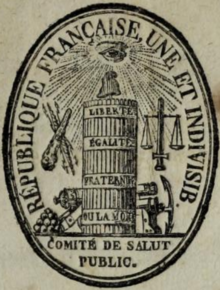Welfare committee
The Welfare Committee ( French Comité de salut public ) was set up on April 5 and 6, 1793 during the French Revolution by the National Convention as a committee of public welfare and general defense . He served as the executive body of the National Convention.
prehistory
The National Convention had set up a total of 18 committees of various competencies and sizes, between which there were often problems of competence. Therefore, from January 4, 1793, a General Defense Committee was established, which consisted of three members each of the seven most important committees.
Since this committee proved to be ineffective and even had to endure biting ridicule from Dumouriez , the welfare commission with 25 members was set up on March 25, including the veteran of the revolution Emmanuel Joseph Sieyès , but also Georges Danton and Maximilien Robespierre .
history
The organization changed again on April 6th, when the part of the welfare committee called the "welfare committee" was separated from the actual security committee (Comité de sûreté générale) and now had nine (later twelve) members. Its main task was originally to control the Convention and the government, as well as to coordinate the defense of the revolution internally and externally. In urgent cases he could also suspend the orders of the ministers and take necessary measures independently. His power of attorney was limited to one month and then had to be renewed, just as the members were only elected for one month.
After the less radical Girondins had been eliminated in mid-1793, the Jacobin leaders ( Robespierre , Danton (who had already been among the first members of the committee and who had been replaced by Robespierre on July 27, 1793) and Louis Antoine de succeeded Saint-Just ) to bring the committee under their control. By the end of 1793 they converted the Welfare Committee into the central switchboard of power. On October 10, the body was granted unrestricted powers. Especially under the influence of Robespierre, the welfare committee, endowed with dictatorial powers, became the organ of the Jacobin reign of terror .
In September 1793 the committee passed a "law against the suspects" in order to be able to fight the enemies of the republic. Revolutionary courts emerged which sentenced the accused without objecting to the verdict. Accusations and suspicions became more frequent. Nobody trusted the other anymore. During this time around 500,000 people were arrested and 40,000 of them were sentenced and executed.
On 9th Thermidor II, July 27th 1794, Robespierre and his followers were overthrown and executed . Some see the reign of terror of the welfare committee and the revolutionary tribunal as the cause . Others see the overthrow as the result of a bourgeois and petty-bourgeois counterrevolution, with one following every revolution and this time being successful (compare, for example, Soviet Thermidor ).
The committee's influence was then limited to the management of military and diplomatic affairs. In October 1795 it was finally dissolved completely.
Members
First welfare committee
The first welfare committee (April to July 1793) consisted of the following members:
- Bertrand Barère , Member of Parliament from the Hautes-Pyrénées department
- Théophile Berlier , from Côte d'Or (June 25 to July 30, 1793)
- Jean-Jacques Bréard , from Charente-Inférieure , resigned June 25, 1793
- Pierre Joseph Cambon , from Hérault
- Georges Danton , from Paris
- Jean Antoine Debry , from Aisne , resigned and replaced by Robert Lindet , from Eure
- Jean-François Delacroix , from Eure-et-Loir
- Jean-François Delmas , from Haute-Garonne
- Louis Bernard Guyton-Morveau , from Côte d'Or
- Jacques Alexis Thuriot , from Marne
- Jean-Baptiste Treilhard , from Seine-et-Oise , resigned June 16, 1793
Time of terror
From September 20, 1793 to July 27, 1794, the composition of the Welfare Committee was unchanged (with the exception of Hérault de Séchelles):
- Bertrand Barère from the Hautes-Pyrénées department
- Jacques Nicolas Billaud-Varenne , MP from Paris
- Lazare Carnot , from Pas-de-Calais
- Jean-Marie Collot d'Herbois , from Paris
- Jeanbon St. André , from Lot
- Georges Couthon , from Puy-de-Dôme
- Marie-Jean Hérault de Séchelles , from Seine-et-Oise (excluded in December 1793, executed April 5, 1794)
- Pierre Louis Prieur , from Marne
- Claude-Antoine Prieur , from Côte-d'Or
- Maximilien de Robespierre , from Paris
- Louis Antoine de Saint-Just , from Aisne
- Robert Lindet , from yours
Welfare Committee 1871
Also during the Paris Commune in 1871 there was a welfare committee for a short time, including Charles Delescluze and Raoul Rigault .
See also
Individual evidence
- ↑ Axel Kuhn, The French Revolution , Reclams Universal Library No. 17017, p. 103, Stuttgart 2009, ISBN 978-3-15-017017-5
